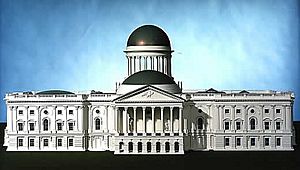William Thornton facts for kids
Quick facts for kids
William Thornton
|
|
|---|---|
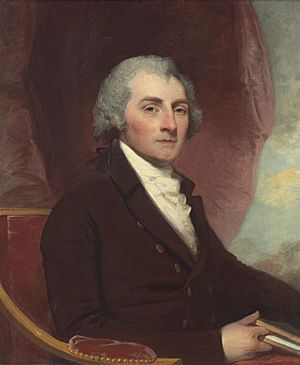 |
|
| Architect of the Capitol | |
| In office 1793–1802 |
|
| President | George Washington John Adams Thomas Jefferson |
| Preceded by | Position established |
| Succeeded by | Benjamin Henry Latrobe |
| 5th Commissioner of the Federal City | |
| In office September 12, 1794 – July 1, 1802 |
|
| Preceded by | David Stuart |
| Succeeded by | Office retired |
| Personal details | |
| Born | May 20, 1759 Jost Van Dyke, British Virgin Islands |
| Died | March 28, 1828 (aged 68) Washington, D.C., United States |
| Resting place | Congressional Cemetery |
| Nationality | British American |
| Alma mater | University of Edinburgh; University of Aberdeen |
| Profession | Architect |
| Known for | United States Capitol |
| Awards | Magellanic Premium (1792) |
| Military service | |
| Branch/service | District of Columbia Militia |
| Years of service | 1807-1815 |
| Rank | Captain |
William Thornton (May 20, 1759 – March 28, 1828) was an American doctor, inventor, painter, and architect. He is most famous for designing the United States Capitol building. He also served as the first Architect of the Capitol and later became the first leader of the United States Patent Office.
Contents
Early Life and Education
William Thornton was born on Jost Van Dyke in the British Virgin Islands. His family were Quakers, a religious group known for their simple lifestyle. When he was five, he was sent to England for his education.
He grew up in Lancaster, England, with his father's Quaker relatives. Even though he had money, he was trained for a useful life. From 1777 to 1781, he was an apprentice to a doctor and pharmacist in Ulverston, England.
During his apprenticeship, Thornton kept a journal. He drew and sketched almost as much as he studied medicine. He drew plants, animals, portraits, landscapes, and even machines. He even built a camera obscura, which is a device used to project images.
In 1781, he began studying medicine at the University of Edinburgh in Scotland. He also spent time in London and Paris to continue his studies. In 1784, he earned his medical degree from the University of Aberdeen in Scotland.
After his studies, Thornton returned to Tortola in 1786. He was concerned about the issue of slavery, which was common on the sugar plantations that were a source of his family's income. He moved to Philadelphia in 1786, hoping to help with the anti-slavery movement. In 1788, he became an American citizen. In 1790, he married Anna Maria Brodeau.
Architectural Career
Designing the U.S. Capitol
In 1789, after working as a doctor and exploring ideas for steamboats, Thornton entered a design competition. He submitted a plan for the new hall of the Library Company of Philadelphia. His design won, and the building was considered one of the first "modern classical" buildings in the United States.
While visiting Tortola between 1790 and 1792, Thornton heard about the design competitions for the U.S. Capitol and the "President's House" (now the White House). When he returned to Philadelphia, he was allowed to submit a design for the Capitol.
On January 29, 1793, Thornton's design for the Capitol was submitted. President George Washington officially approved it on April 2, 1793. Thornton's design was inspired by famous buildings like the Louvre in Paris and the Pantheon in Rome. Secretary of State Thomas Jefferson praised the design, calling it "simple, noble, beautiful, excellently distributed." For winning, Thornton received $500 and a city lot.
The construction of the Capitol was overseen by Étienne Sulpice Hallet and James Hoban. On September 12, 1794, President Washington appointed Thornton as one of the three "Commissioners of the Federal District." In this role, he helped plan the new federal city and oversaw the construction of government buildings, including the Capitol. He remained in charge until 1802. Even though changes were made to his original plan over time, much of the central part of the Capitol's design is still his.
Other Notable Buildings
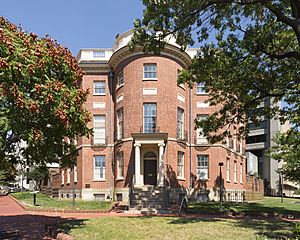
After winning the Capitol competition, Thornton was often asked to design other buildings in the new Federal City. He created designs for several public and private buildings.
One of his most famous designs is The Octagon House in Washington, D.C., built between 1799 and 1800. This house served as a temporary "Executive Mansion" after the White House was burned by the British in 1814. It was also where President James Madison signed the Treaty of Ghent, which ended the War of 1812. Today, the building is owned by the American Institute of Architects.
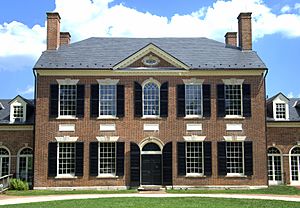
Around 1800, Thornton designed Woodlawn for Lawrence Lewis, who was George Washington's nephew, and his wife, Eleanor Parke Custis Lewis. He also designed Tudor Place around 1808 for Martha Parke Custis Peter, another granddaughter of Martha Washington.
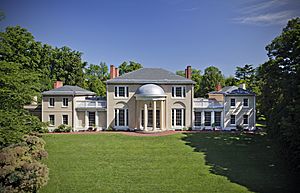
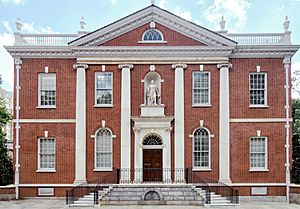
Buildings on the National Register
Many buildings designed by William Thornton are now listed on the National Register of Historic Places. This means they are important historical sites. Some of these include:
- Library Company of Philadelphia, Philadelphia, PA; 1789 (recreated as Library Hall, American Philosophical Society, 1954)
- United States Capitol, Washington, D.C.; 1793
- Prospect Hill, Baltimore, MD; 1796-1798
- Prospect House, Washington, D.C.;
- Octagon House, Washington, D.C.; 1799
- Woodlawn, Fairfax, VA; 1800-05
- Tudor Place, Washington, D.C.; 1816
Washington Jockey Club
In 1802, the Washington Jockey Club needed a new location for its horse racing track. The old track was in an area that was becoming too developed in the growing Federal City.
William Thornton, along with other important figures like John Tayloe III and Charles Carnan Ridgely, helped move the races. Thornton designed the new track, which was one mile long. He named it the Washington City Race Course. This track was used until the mid-1840s.
Superintendent of the Patent Office
In 1802, President Thomas Jefferson appointed William Thornton as the first Superintendent of the United States Patent Office. This office is where new inventions are registered and protected.
When the British burned Washington, D.C., in 1814 during the War of 1812, Thornton convinced them not to burn the Patent Office. He argued that the inventions stored there were important for all of mankind. He held this position from 1802 until his death in 1828. During his time, he introduced new ideas, like the practice of reissuing patents.
Societies and Later Life
In 1787, Thornton was chosen to be a member of the American Philosophical Society. This was a respected group of thinkers and scientists. In the 1820s, he was also part of the Columbian Institute for the Promotion of Arts and Sciences. This society included important people like former presidents Andrew Jackson and John Quincy Adams.
William Thornton died in 1828 and was buried in Congressional Cemetery in Washington, D.C.
See also
- Richard Humphreys (philanthropist)
- John C. Lettsome



